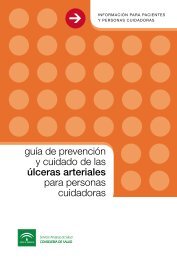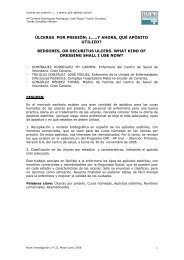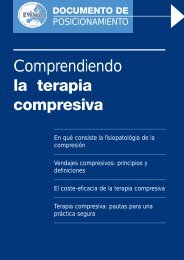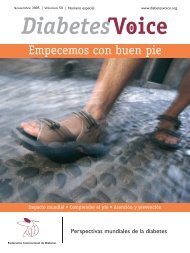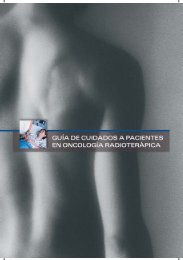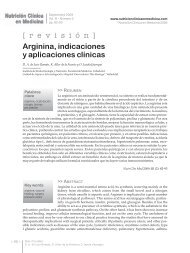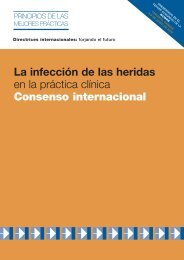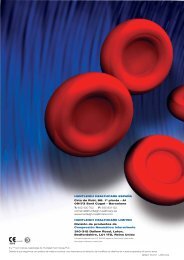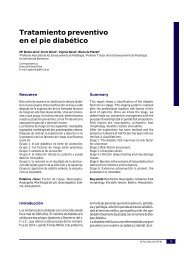NEGATIVE PRESSURE WOUND THERAPY IN DIABETIC FOOT WOUNDS ■ 117on dressings removal. Conversely, PU foam isrecommended when a rapid surface granulationresponse is desired, as is the case oflarge, deep, uniformly shaped wounds withfew contours or tunnels (46). Because of thelack of shape memory, gauze may contourbetter the surface of complex-shaped woundsand it is easier to apply than PU foam, whichrequires extensive pre-shaping and can bevery time consuming (46). PVA foam can alsobe used in these complex wounds since it hasmuch less shape memory than PU foam (47).The WCL is used with the purpose ofminimising tissue ingrowth into the woundfiller material and thereby protecting thewound bed from damage during the removalof wound filler and reducing de patient’s pain.It is recommended to use a non-adherentWCL when using a PU foam-based to bolstera skin graft. However, the use of a less adhe -rent filler such as gauze or PVA foam mayremove the need for additional WCL (37).Pressure levelUpon the adoption of commercial NPWT,a standard pressure setting of -125 mmHgbecame the accepted norm. In recent years,the need to modify the pressure settings for avariety of reasons suggested a benefit of arange of negative pressure levels between -40and -150 mmHg instead of a fixed value.Several in vivo studies suggest that pressuresfrom -40 to -80 mmHg are oftenenough to determine wound contraction andthat increasing pressure beyond this pointresulted in little additional contraction (39,40, 48). Other in vivo studies have also consistentlydemonstrated increased blood flow atpressures ranging from -50 to -175 mmHg(49-51).Microdeformation of the wound surfacewas also observed with pressures of -75 and-125 mmHg (40). The effect of varying levelsof pressure on formation of granulation tissuehas been evaluated in two animal studies (4,13) and one clinical study (52). The maximalgranulation tissue formation occurs in therange from -50 to -125 mmHg.The higher level of negative pressure isassociated to increased discomfort expe -rienced by the patient (49) and thereby lowernegative pressures may be considered toreduce pain.Avoidance of higher levels of negativepressure is also recommended in woundswith vascular compromise since NPWTreduces blood flow in immediate vicinity ofthe wound and this effect becomes more pronouncedwith increasing negative pressure(6, 43).On the other hand, when management ofhigh levels of exudate is a specific treatmentgoal, a higher level of negative pressure (withinthe therapeutic range of 50-150 mmHg)may be needed to adequately manage thewound fluid (54).Continuous or intermittent deliveryof pressureIntermittent delivery of pressure, whichinvolves cyclical release and reapplication ofpressure, in a typical pattern of 5 minutes onand 2 minutes off, has been shown to increasethe rate of granulation tissue formation (4,55) compared to continuous pressure.However, intermittent pressure delivery canexacerbate the pain that is experienced bythe patient at every cycle. Furthermore, duringthe off phase, exudate can accumulate andbreak the adhesive film seal. Borquist et al.(55) demonstrated that a «variable» therapyproviding smooth cycles of two different levelsof negative pressure is almost as effectiveas conventional intermittent pressure butpreferable to patients.Drainage conduitNegative pressure may be applied using anon-perforated drainage tube connected tothe top of the dressing or a perforateddrainage tube within the wound filler. Malmsjet al (56) reported that, for «wet» wounds,perforated drains inserted into the woundfiller transmitted negative pressure to thewound bed more efficiently than non-perfo-
118 ■ PIE DIABÉTICOrated drains on the surface, regardless thewound filler used (gauze or foam). Accordingto this observation, the choice of drainagetechnique may be particularly important inwounds with a large volume of exudate.NPWT IN THE TREATMENTOF LOWER LIMB ISCHEMICWOUNDS AT OUR DEPARTMENTWe have reviewed the results of the recentexperience using NPWT in the treatment oflower limb ischemic wounds at our department,which comprises 23 patients, including 22with the diagnosis of Diabetes Mellitus. Most ofthe patients (21) underwent endovascular orconventional limb revascularization beforeapplication of NPWT, according to the type andextension of vascular disease. The remaining 2patients had an anatomical pattern of diseaseconsidered not suitable for surgery.The lower extremity wounds included 11foot lesions resulting from toe amputation, 3after transmetatarsal amputation, 5 foot ulcersand 4 leg ulcers (Figure 3). All those woundswere selected to NPWT because of its largedimensions, depth and exudate production.The level of pressure ranged between -100 and -125 mmHg, the filling material usedwas the PU foam, due to its lower cost, anddressings were changed every 72 hours. Thetreatment with NPWT was discontinuedwhen all the wound bed was filled with granulationtissue or if there was no response ofthe wound to therapy. This treatment hasbeen applied for a mean of 22 days (6 to 40days).Most of the patients (19 patients: 82%)achieved a positive outcome with 10 woundsundergoing successful skin graft and 9 progressingto secondary intention healing. In theremaining 4 patients the wounds have wor -sening in spite of the NPWT, requiring abelow-knee amputation in 3 cases and anabove-knee amputation in the other one(Figure 4).Figure 4. Outcomes of NPWT in ischemic woundsat our department revision.CONCLUSIONFigure 3. Type of ischemic wounds undergoingNPWT at our department revision.NPWT has proven to be effective in thewound protection and improvement of healingprocess, allowing a faster surgical graftingor secondary intention closure. Theseimproved outcomes, compared to conventionaltherapy, contribute to improve patientcomfort and result in a significant reductionof costs. It is thereby a valuable tool that mustbe used to improve the care of foot lesions indiabetic patients and reduce the risk of associatedamputations.REFERENCES1. Singh N, Armstrong DG, Lipsky BA. Preventing foot ulcersin patients with diabetes. JAMA 2005;293:217-28.





